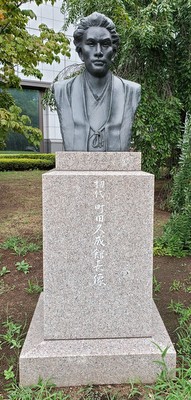Difference between revisions of "Machida Hisanari"
| (One intermediate revision by the same user not shown) | |||
| Line 1: | Line 1: | ||
| − | *''Other Names'': 上野良太郎 ''(Ueno Ryôtarô)'' | + | [[File:Machida-hisanari.jpg|right|thumb|400px|Bust of Machida at the Tokyo National Museum]] |
| + | *''Born: [[1838]]'' | ||
| + | *''Died: [[1897]]'' | ||
| + | *''Other Names'': 上野良太郎 ''(Ueno Ryôtarô)'', 石谷 ''(Sekikoku)'' | ||
*''Japanese'': [[町田]]久成 ''(Machida Hisanari)'' | *''Japanese'': [[町田]]久成 ''(Machida Hisanari)'' | ||
| Line 8: | Line 11: | ||
In [[1873]], he co-authored a book on [[falconry]] entitled ''Takagari ichiran'' along with [[Suga Soho|Suga Sôho]].<ref>Gallery labels, British Museum.[https://www.flickr.com/photos/toranosuke/20880070762/in/dateposted-public/]</ref> | In [[1873]], he co-authored a book on [[falconry]] entitled ''Takagari ichiran'' along with [[Suga Soho|Suga Sôho]].<ref>Gallery labels, British Museum.[https://www.flickr.com/photos/toranosuke/20880070762/in/dateposted-public/]</ref> | ||
| − | After the Tokyo National Museum was first established in [[1881]], Machida was named its first director the following year. He intended for the museum to be a universal museum, like the British Museum in London, collecting and displaying artifacts from all the cultures of the world. He was a strong supporter of historical research, heritage conservation, and the collection of artifacts for the museum, and helped organize a number of International Expositions to be held in Tokyo which would bring in more objects from across the country and all over the world, to be incorporated into the museum's collections. | + | After the Tokyo National Museum (at that time called the Ueno Museum) was first established in [[1881]], Machida was named its first director the following year. He intended for the museum to be a universal museum, like the British Museum in London, collecting and displaying artifacts from all the cultures of the world. He was a strong supporter of historical research, heritage conservation, and the collection of artifacts for the museum, and helped organize a number of International Expositions to be held in Tokyo which would bring in more objects from across the country and all over the world, to be incorporated into the museum's collections. |
| − | Machida also served for a time as a member of the short-lived [[Genroin|Genrôin]] legislature. | + | Machida also served for a time as a member of the short-lived [[Genroin|Genrôin]] legislature, and played a prominent role in organizing national and international expositions. After retirement, he took the [[tonsure]], and later became abbot of a branch temple of [[Miidera]] (Onjôji) under the monastic name Sekikoku. |
{{stub}} | {{stub}} | ||
| Line 16: | Line 19: | ||
==References== | ==References== | ||
*Plaque at Satsuma students monument outside Kagoshima Chûô train station.[https://www.flickr.com/photos/toranosuke/21519295436/sizes/o/] | *Plaque at Satsuma students monument outside Kagoshima Chûô train station.[https://www.flickr.com/photos/toranosuke/21519295436/sizes/o/] | ||
| + | *Plaque at Tokyo National Museum.[https://www.flickr.com/photos/toranosuke/48830040487/sizes/k/] | ||
<references/> | <references/> | ||
[[Category:Meiji Period]] | [[Category:Meiji Period]] | ||
[[Category:Samurai]] | [[Category:Samurai]] | ||
Latest revision as of 09:53, 21 April 2020
- Born: 1838
- Died: 1897
- Other Names: 上野良太郎 (Ueno Ryôtarô), 石谷 (Sekikoku)
- Japanese: 町田久成 (Machida Hisanari)
Machida Hisanari was the first director of the Tokyo National Museum.
He was one of nineteen young men from Satsuma han who traveled surreptitiously to Europe in 1865 to study, and to bring back modern technology to aid in Satsuma's modernization & industrialization efforts. Twenty-eight years old at the time, he helped direct the studies of the younger members of the mission, including two of his younger brothers, Machida Sanetsumi and Seijirô, and took on another name for the duration of the journey: he was known as Ueno Ryôtarô while abroad.
In 1873, he co-authored a book on falconry entitled Takagari ichiran along with Suga Sôho.[1]
After the Tokyo National Museum (at that time called the Ueno Museum) was first established in 1881, Machida was named its first director the following year. He intended for the museum to be a universal museum, like the British Museum in London, collecting and displaying artifacts from all the cultures of the world. He was a strong supporter of historical research, heritage conservation, and the collection of artifacts for the museum, and helped organize a number of International Expositions to be held in Tokyo which would bring in more objects from across the country and all over the world, to be incorporated into the museum's collections.
Machida also served for a time as a member of the short-lived Genrôin legislature, and played a prominent role in organizing national and international expositions. After retirement, he took the tonsure, and later became abbot of a branch temple of Miidera (Onjôji) under the monastic name Sekikoku.
